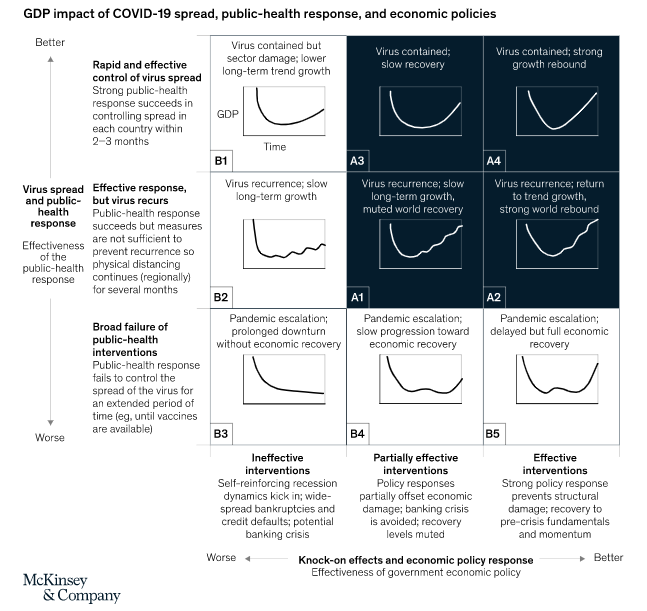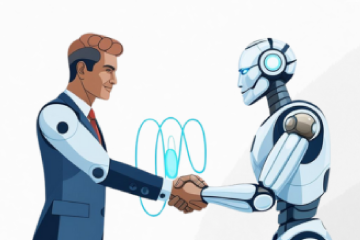4-step action plan for business leaders during COVID-19
4 Step Action Plan For Business Leaders During COVID-19

The coronavirus outbreak is first and foremost a human tragedy, affecting hundreds of thousands of people. It is also having a growing impact on the global economy. This article is intended to provide business leaders with a perspective on the evolving situation and implications for their companies.

Many leaders currently expect one of the scenarios shaded (A1–A4) to materialize. In each of these, the COVID-19 spread is eventually controlled, and catastrophic structural economic damage is avoided. These scenarios describe a global average, while situations will inevitably vary by country and region. But all four of these scenarios lead to V- or U-shaped recoveries.
Other, more extreme scenarios can also be conceived, and some of them are already being discussed (B1–B5). One can’t exclude the possibility of a “black swan of black swans”: structural damage to the economy, caused by a yearlong spread of the virus until a vaccine is widely available, combined with the lack of policy response to prevent widescale bankruptcies, unemployment, and a financial crisis.
Source: McKinsey & Co.
Amid the chaos and all the redundant advice, it’s hard to differentiate what to focus on and what to not! We suggest business leaders should focus their time on four critical areas:
Support and protect employees through thick-and-thin.
Many organizations have put basic assurances in place for their employees and customers. For employees working from home or working remotely, interruptions are far more frequent than in the office environment. Isolating ourselves through the already isolated life is tough. Workers are now feeling certain that they lack the skills to be successful in working through a remote environment, networking, and creating routines that enhance productivity. Employees have a constant fear that staying remote could make them less valuable, especially through the current economic conditions.
Three primary actions are essential:
- Companies need to increase communication, balance the needs of the business by setting expectations and building the morale of the team. This ensures that your employees know that their well-being is at the top of your mind.
- Change the working norms and try making remote work practical and simple whenever possible. While employees adapt to a newer lifestyle, companies need to take a leap too.
- And of course, protect your people’s health with basic measures appropriate to the workplace. These include fostering positive hygiene habits, providing personal protective equipment, amending sick-leave policies; technically, whatever it takes to ensure the health and safety of your employees.
Monitor leading indicators of market trends as the basis of your plans.

Think about the post-COVID-19 phase. In the heat of the moment, it’s easy to incline towards thinking short-term and lose sight of the actions required to safeguard your tomorrow—and the day after that. Evolve the CoE to plan for the next phase. Every assumption made at this stage of the business is open to reasoning.
Strategise for a jump-start for when the situation is conducive for your business again.
Having experienced a radical change in their lifestyle, consumers are re-evaluating their spends, hinting that spends may permanently shift between categories and that online services could see a boost in adoption. Decoding this new mundane—and ensuring that the company has a strategy to leverage it—is an important KRA of a CoE. Approaches such as creating a diverse portfolio of initiatives and contingent planning for leadership under uncertain situations can go a long way toward creating a blueprint for business leaders to follow.
Prepare for the worst, under worst-case scenarios

In an economic slowdown, cost-cutting is inevitable. But that does not mean compromising on good customer experience, which can substantially reduce the value. Ideally, the best way to improve the customer experience and efficiency at the same time is to increase the digital and self-service channels and make smarter operational trade-offs; all aligned with what matters most to customers. In a banking industry, for example, digital servicing and sales are less expensive than branch- and phone-based approaches. The problem for many banks is that in smaller cities, the adoption is very low because they find digital channels unsafe and intimidating. Transitioning customers on digital channels is often a successful way to boost savings and improve customer satisfaction. Teams can adopt this cost-cutting mindset, migrate customers to self-serve channels, by radically simplifying a product portfolio, and in-turn optimizing the service-level agreements.
CX has taken on a new definition and dimension during the overwhelming struggle during COVID-19. Customer leaders who are agile during the crisis and anticipate customers’ changes in behaviour will build stronger relationships that will endure well beyond the crisis’s passing.
We at LitmusWorld hope the best for your business and the people driving it. Feel free to reach out to us at www.litmusworld.com/contact-us for any support. To ensure business continuity, it is important to constantly engage with customers, stay abreast with the changing customer expectations and adapt to changing customer needs.
LitmusWorld’s People Pulse offering will enable you to measure your customer expectations and their experience from the increasing use of self service channels, create action plans for the post-COVID phase and ensure that customer’s do feel confident of having a relationship with your brand.
Stay safe.

